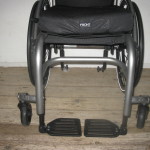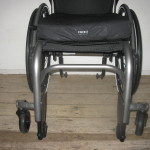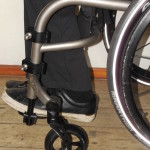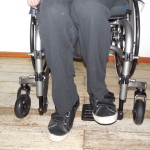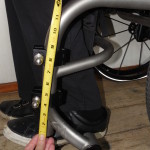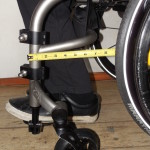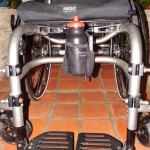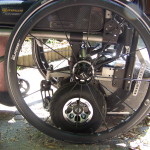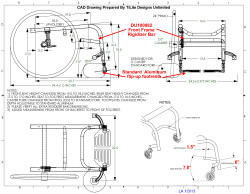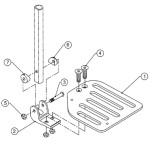Custom Front Frame Rigidizer Bar (DU100082)
Most rigid chairs have a solid footrest with a rigidizer bar underneath the footrest. We needed flip-up footrests which required a Designs Unlimited modification by TiLite (DU100082). This put the rigidizer bar higher up on the front frame to be able to support 2 individual flip-up footrests.
There was not a lot of information from TiLite about spec’íng this out, and our dealer had very little experience with the DU100082 modification. This meant that we had to figure this out on our own with the help of others who have posted information on CareCure Equipment forums with photo’s and CAD drawings (special thanks to SCI_OTR).
Height dimension: 6″
Our requirements were to have the rigidizer bar as high up as possible, because we wanted to be able to place the chair on the back seat of our auto (as how a person would sit). We also needed to leave enough room under the seat frame to be able to have other parts workable, like brakes, which we estimated to be about 4-4.5″ to be safe. We also wanted enough room above and below it for a Firefly Power Handbike that mounts on the front frame.
Because the height dimension is based on the bottom of the front frame, we had no exact way to know what this was. We could make a guesstimate based on the casters, but it was not exact. We asked TiLite to include the dimension from the front seat height with the CAD and it really helped to make sure there was enough space. It would be good if TiLite measures this dimension from the front seat height (FSH), because that is a dimension that we knew, and we would not have required a CAD drawing to verify it.
We are happy we did the height dimension a little higher than we had originally planned. Possibly we could have gone higher, but I still have no idea if that would have been good or bad structurally. It works well in the back seat of the car and there is enough room for the Firefly brackets on the front frame, with one below and the other above the rigidizer bar. There is no interference with brakes, and having it higher makes it convenient for a bottle holder/bag that we have fixed to the bottom of it.
Depth dimension: 1.5″
The depth dimension was just as tricky to configure. We wanted it to be far enough back to allow for good foot propulsion (toddling), but not so far back that it interfered with our plans to get the Spinergy ZX-1 Power add-on that mounts to the back of the camber tube and requires 6″ in front of it. We were not exactly sure about this measurement, because the ZX-1 was not yet on the market.
This dimension is measured from where the seat upholstery starts. Because we had an extra 1″ on the frame length, it was not clear where the measurement actually started behind the bend, and we had to guesstimate. It would have been better if TiLite measures this from the seat post, because that is a dimension that we were sure of, and it would not have required an extra CAD drawing to verify.
We are happy we did the depth dimension less than some that we saw on other chairs, e.g., 3″. We find that it works a bit like a calf strap in preventing his affected foot from falling off the footrest. I’m glad we did not do any less, because I think it would have got in the way of foot propulsion. There is also no issue with it getting in the way of the ZX-1, and even a few more inches would not have mattered, due to the long 18″ + 1″ seat depth.
Angle dimension: 7°
This dimension was not quite as tricky, but again, it would have helped to have some guidance. For example, I did not know what the structural implications were for strength of this dimension, or the others, in relation to the front frame and stability. I based this dimension on the idea that the less angle it had, the more it would be like the rigidizer bar that the footrest would normally mount on if it had, perpendicular to the ground.
Also, with wanting to keep space under the seat frame, we did not want it too extreme, and for asthetics, I thought that many that were at a higher angle, i.e., 15° or more, did not flow well with the lines of the chair. Again, it was a guesstimate, but we think it worked out fine.
We are happy we did the angle dimension less than what we saw on other chairs, e.g.,15°. Possibly we would consider having an angle at 0°, but that would be purely for asthetics.
A note on the uneven welded rigidizer bar
After measuring everything up we realised that the rigidizer bar was not welded completely straight, and there is about a 1/8″ (3mm) difference. The rigidizer bar has 1 1/8″ (28.575mm) tubing. This has caused us some extra work with mounting the Firefly brackets to get them level in a small amount of space, but overall it is still workable.
We were a bit concerned about any impact the uneven welded rigidizer bar might have with the stability and strength of the chair, and also about the warranty. We asked TiLite to respond about this, and this was the reply:
After discussions with the Engineering Department, Tilite will back the warranty 100% on ZRA Series 2, serial number #########, dispite the cosmetic flaw of the uneven welded rigidizer bar.
The chair should continue to perform like any other chair with no additional problem, because of the structure of the frame, as long as the chair is properly maintained.
Standard Aluminum flip-up footrests / footplates
Choosing the best individual flip-up footrests was also a difficult decision to make, because usually rigid chairs have fixed footrests. The following were the Standard footrest options for DU100082:
❑ Aluminum flip-up
❑ Composite flip-up
❑ Depth adjustable flip-up
❑ Angle adjustable flip-up
❑ Depth and angle adjustable flip-up
We already had Composite flip-up’s on the 2GX, and I knew that their profile might get in the way and was concerned that they might flop down over time, making foot propulsion difficult, because there would be no way to attach them to the front frame if that happened. The idea is that we can use a magnet if the aluminum flip-up footrests start to drop down and get in the way of transfers.
I would have possibly chosen Depth and angle adjustable flip-up to give the most choice, but decided against it after seeing in the CAD drawings what appears to be parts that might also get in the way of foot propulsion and they looked heavier with the possibility of causing forward tippiness. They would have also added more complexity and probably extra weight.
The standard Aluminum flip-up’s work well, and I am glad that we did not get the Depth adjustable flip-up’s, because they are much larger and not really necessary. They seem to have the most minimal profile to not extend into the foot area too much when doing foot propulsion. They are set back enough to minimize forward tippiness, and are very solid. After one year we have also not had problems with them dropping down and getting in the way for transfers, but I need to check them every so often and tighten the side that is used a lot.
With a 16″ wide ZRA chair (1.25″ tube), there is 13.5″ between the front frames. Once the foot plates are added, about .5” is lost on each side because of the flip-up footplate pivot, which makes it about 12.5″ in total between the front frames. There is enough room for my husband to foot propel comfortably, and wide enough for transfers.
For anyone else considering this option, it’s important that you do not get any V-front taper on the front frame or there will not be enough room to foot propel. In an ideal world, we would have an adjustable width front frame, perhaps even extending out further than the seat width, which would help for turning and maneuvering with one foot/leg.
